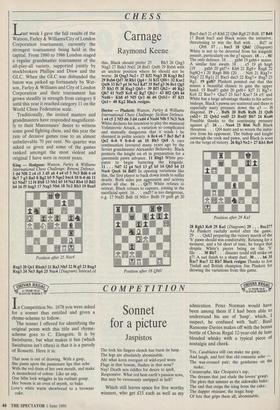CHESS
Carnage
Raymond Keene
Last week I gave the full results of the Watson, Farley & Williams/City of London Corporation tournament, currently the strongest tournament being held in the capital. From 1980 to 1986 London staged a regular grandmaster tournament of the all-play-all variety, supported jointly by stockbrokers Phillips and Drew and the GLC. When the GLC was disbanded the baton was picked up fortunately by Wat- son, Farley & Williams and City of London Corporation and their tournament has grown steadily in strength from category 8 until this year it reached category 11 on the World Chess Federation scale.
Traditionally, the invited masters and grandmasters have responded magnificent- ly to their Maecenases' desire to witness some good fighting chess, and this year the rate of decisive games rose to an almost unbelievable 70 per cent. No quarter was asked or given and some of the games ranked amongst the most violent and original I have seen in recent years.
King — Hodgson: Watson, Farley & Williams International Chess Challenge; Benoni Defence. 1 d4 Nf6 2 c4 c5 3 d5 a6 4 a4 e5 5 Nc3 Bd6 6 e4 Bc7 7 g3 Ba5 8 Bg2 b5 9 Nge2 bxc4 10 0-0 d6 11
h3 Nbd7 12 f4 Rb8 13 Nbl h5 14 Na3 Rb4 15 Bd2 h4 16 15 Nxg3 17 Nxg3 Nb6 18 Nc2 Rb3 19 BxaS Position after 25 Nxc4
Rxg3 20 Qel Rhxh3 21 Ra3 Nh5 22 f6 g5 23 Rxg3 Rxg3 24 Ne3 Bg4 25 Nxc4 (Diagram) Instead of this, Black should prefer 25 . . . Bh3 26 Qxg3 Nxg3 27 Bxh3 Nxfl 28 Bxfl Qxf6 29 Bxb6 with an unclear position where he should not be worse. 26 Qxg3 Ne2+ 27 Kf2 Nxg3 28 Kxg3 Be2 29 Bxb6 Qd7 30 Rhl Qg4+ 31 Kf2 Qf4+ 32 Kxe2 Qxf6 33 Bc7 g4 34 Ne3 Kd7 35 Ba5 g3 36 Bel Qg5 37 Rh3 f5 38 Rxg3 QhS+ 39 Bf3 Qh2+ 40 Rg2 Qh7 41 Nxf5 Kc8 42 Rg7 Qh2+ 43 Bf2 Qf4 44 Nxd6+ Kb8 45 Nf5 Qcl 46 d6 Qxb2+ 47 Kfl Qat + 48 Kg2 Black resigns.
Hector — Plaskett: Watson, Farley & Williams International Chess Challenge; Sicilian Defence. 1 e4 c5 2 Nf3 d6 3 d4 cxd4 4 Nxd4 Nf6 5 Nc3 Nc6 White declares his intention to play the maniacal Velimirovic Attack, a variation so complicated and mutually dangerous that it tends t be shunned in polite society. 6 Bc4 e6 7 Be3 Bel 8 Qe2 0-0 9 0-0-0 a6 10 Bb3 Qe8 A rare continuation favoured many years ago by the Soviet grandmaster Alexander Beliaysky. Black protects the knight on c6 in preparation for a queenside pawn advance. 11 Rhgl White pre- pares to begin battering the kingside. 11 . . . Nd7 12 g4 Nc5 13 g5 b5 14 Qh5 b4 15 Nxc6 Qxc6 16 Bd5! In opening variations like this, the first player to back down tends to suffer dearly. Both sides put aggression and activity above all else. 16 . . . Qc7! White refuses to retreat, Black refuses to capture, joining in the sacrificial spirit. 16 . . . exd5? is too dangerous, e.g. 17 Nxd5 Bd8 18 Nf6+ Bxf6 19 gxf6 g6 20
Position after 18 Qh6!
Bxc5 dxc5 21 e5 Kh8 22 Qh6 Rg8 23 Rd8. 17 Bd4 17 Bxa8 bxc3 and Black seizes the initiative, threatening to win the Ba8 with . . . Bd7 or . . Qb8. 17 . . . bxc3 18 Qh6! (Diagram) White is not to be deterred from his kingside assault, particularly on the g7 square. 18 . . . f6! The only defence. 18 . . . gxh6 19 gxh6+ mates. A similar fate awaits 18 . . . e5 19 g6 hxg6 (19 . . . gxh6 20 gxf7+ Kh8 21 Rg8+ Rxg8 n fxg8Q+) 20 Rxg6 Bf6 (20 . . . Ne6 21 Rxg7+ Nxg7 22 Rgl) 21 Bxc5 dxc5 22 Rxg7+ Bxg7 23 Rgl. 19 gxf6? Plaskett pointed out that this misses a beautiful chance to gain the upper hand. 19 Bxa8!! gxh6 20 gxf6+ Kf7 21 Rg7+ Ke8 22 Rxe7+ Qxe7 23 fxe7 Kxe7 24 e5! and White has a large advantage thanks to his active bishops. Black's pawns are scattered and there is especially nasty pressure down the a3 — f8 diagonal. 19 . . . Bxf6 20 Bxf6 Rxf6 21 Qxf6 cxb2+ 22 Qxb2 exd5 23 RxdS Bbl 24 Rxd6 Possible thanks to the continuing pressure against g7. 24 . . . Nxe4 25 Rb6 Nc3! Black threatens . . . Qf4 mate and so wrests the initia- tive from his opponent. The bishop and knight outweigh the rook and pawn, and Black is soon on the verge of victory. 26 Rg3 Ne2+ 27 Kbl Be4
Position after 29 Kal
28 Rgb3 Rc8 29 Kal (Diagram) 29 . . . Bxc2?? As Plaskett ruefully noted after the game, 29 . . . Qxh2 preparing the victory march of the `h' pawn should win comfortably. Relaxing for a moment, and a bit short of time, he forgot that despite White's pieces being on the 'b' file . . . 30 Rb7 . . . disaster could still strike on g7! A sad finish to a sharp duel. 30 . . . h6 31 Rxc7 Rxc7 32 Rb7 Black resigns Thanks to Jon Tisdall and British champion Jim Plaskett for showing the variations from this game.


















































 Previous page
Previous page